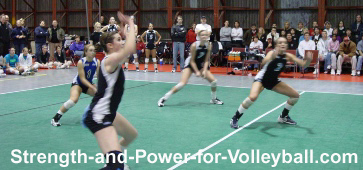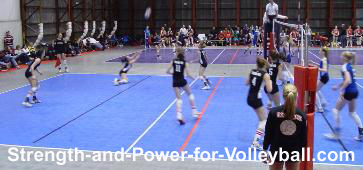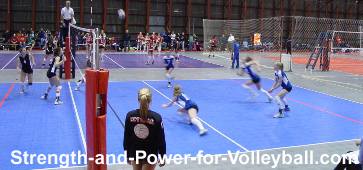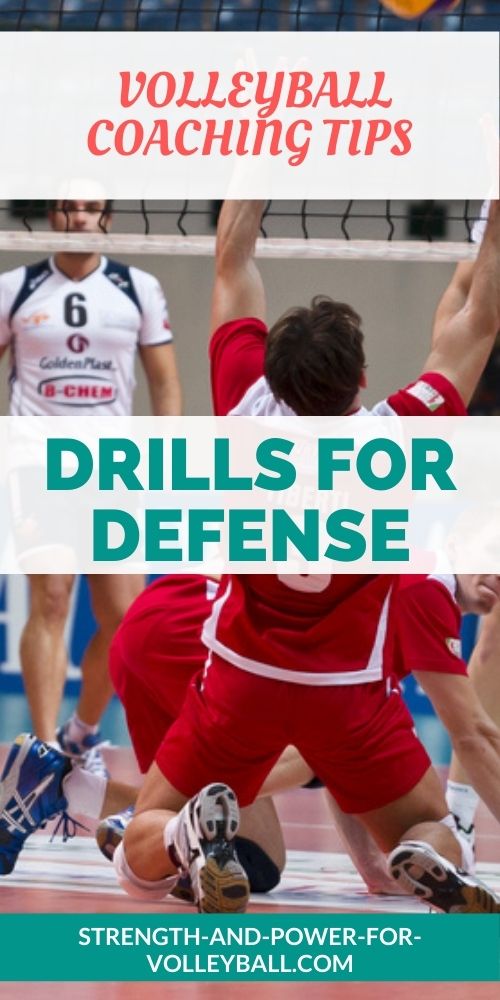How to Dig a Volleyball
Techniques for Defense
Learning how to dig a volleyball is important for playing great defense.
The best teams often develop great ball control which leads to frustrating their opponents into making hitting errors.
Defensive Positioning
When preparing to dig, keep your feet wide enough apart so you are able to react and move quickly in any direction.
Bend your knees and bend at the waist to a leaning forward position.
Preparing to dig...
- Feet are wide with the knees bent and out over your toes
- Shoulders are forward and relaxed
- Arms are bent and out in front of your body
How to Dig a Volleyball
It's best to contact the ball between your knees in front of your body. Ideally, you want to get your hips under the ball so that you have better ball control.
Playing the ball...
- Anticipate and move to the ball
- Get your forearms under the ball
- Lean into the ball as you make contact
- Dig the ball at the midline of your body if you can
- If you have to reach outside your body, extend and angle your arms in the direction of the target
Remember to always change your body position to face the hitter. Hard driven balls are dug often just by getting in good body position. If you are continually able to get into good position for digging (angling your arms to the target every time), you will often dig balls that will stay in play just by them rebounding off of you in the right direction.
Skills for Executing Emergency Plays
Learning how to dive
Diving is more popular in the men's volleyball because it takes greater upper body strength to safely execute a dive.
To execute a dive, run towards the ball, push off your back foot and get airborne.
When first learning skills for diving...
- Start by standing on a gym mat. At first, just lower yourself down to the mat with your hands.
- Next, lower down to the ground and then pull yourself forward with your hands sliding on the ground
- And finally, bend your knees and get really low to the ground. Extend your body forward, get airborne and slide through on your chest. Practice pulling your body forward with your hands to slide even more.
- Once you've built confidence, practice by adding a ball.
Most good attackers have developed an array of tough shots to defend. Skills for keeping the ball off the floor are important to any team's defense.
-
Sprawls
Forward sprawls
Extend your arms underneath the ball and drive the body forward to the floor.
If the ball is below knee height, you must adjust your arms so they are parallel to the floor in order to dig the ball. This is done by bend the elbows or curling the wrists. You may also take a step forward and lean to get into a lower position.
Side sprawls
Sprawl to the side while changing the position of your arms by dropping your inside shoulder. manipulating the position of your arms is important to directing the ball to the target area -
Dives
Diving consists of staying low to the ground, and gliding through the air to make a play on the ball.
Keep your shoulders low
As you are about to dive you want to keep your body low to the ground.
Keep your body parallel to the floor
You shouldnt push up off the ground, but push forward. By pushing forward, you will be better at keeping your body parallel to the ground allowing yourself to slide for a better landing.
Keep your chin up
As you are diving, keep your head and chin up.
Follow through
After you play the ball, place your hands on the ground and pull yourself through by sliding forward.
- Pancakes
A pancake is most often done when a ball is falling to the floor when the nearest defensive players is far away.
take a few steps and dive as far as you can through the air
slide your hand firmly on the ground -
Overhead digs
Learning to play the ball overhead with your fingers when passing the first contact is much different than how you handle the ball for setting attackers. When first learning skills for overhead digging, practice playing the ball with your hands by keeping your fingers and wrists firm and taut. When digging a hard driven ball, make sure you are initiating contact with the ball. If you let the ball play you, there's a better chance of injuring your fingers.
Keep your weight on the balls of the feet ready to push the ball forward
Keep your shoulders behind the ball
Keep fingers and wrists tensed for better ball control
Player's should developed many skills displaying how to dig a volleyball. It's best to be exposed to as many different skills for playing defensive as possible. There are times when a defensive player can't get in correct position and must react to just keep the ball in play. Therefore, player's should be given the opportunity to develop their own unique techniques and strategies for digging.
If you enjoyed these tips and would like to keep it close to you at any time, just save this pin to your Pinterest Volleyball Training Board.
How to Dig a Volleyball Related Pages
Passing TermsVolleyball › Volleyball Techniques › How to Dig a Volleyball



